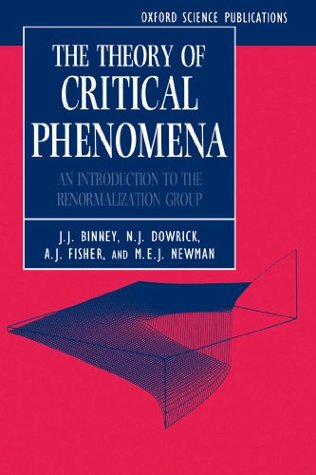Download The Theory of Critical Phenomena: An Introduction to the Renormalization Group (Oxford Science Publications) - J.J. Binney file in ePub
Related searches:
A Primer to the Theory of Critical Phenomena - 1st Edition - Elsevier
The Theory of Critical Phenomena: An Introduction to the Renormalization Group (Oxford Science Publications)
Introduction to the Theory of Critical Phenomena: Mean Field
Contribution to the Theory of Critical Phenomena: The Journal of
The Theory of Boundary Critical Phenomena
A Primer to the Theory of Critical Phenomena ScienceDirect
The theory of equilibrium critical phenomena - IOPscience
The Theory of Boundary Critical Phenomena International
3590 2267 2882 3058 1135 4702 4565 4598 2487 139 1030 4401 1768 3945 4501 3345 17 3248 3651 1175 3744 516 3168 1018 1044 1909 1912 248 758 729 2968 1386 2580 274 1853 1753 4451 3125
An introduction to the modern theory of critical phenomena is presented.
Feb 1, 2019 analyses of critical phenomena have largely focused on static properties, such as free energies, equilibrium expectation values and linear.
Oct 18, 1996 an introduction into the theory of boundary critical phenomena and the application of the field-theoretical renormalization group method to these.
Many of us who are not habitually concerned with problems in statistical physics have gradually been becoming aware of dramatic progress in that field.
May 23, 2019 an important contributor to our current understanding of critical phenomena, ma introduces the beginner--especially the graduate student with.
Landau theory is a mean-field theory approach to phase transitions.
Purchase a primer to the theory of critical phenomena - 1st edition.
Sep 4, 2015 we compute critical properties of a general class of quantum spin chains which are quadratic in the fermi operators and can be solved exactly.
The essential similarity of these early theories, the van der waals theory of the liquid-vapor critical point,.
Suggested citation:3 critical phenomena and phase transitions.
A primer to the theory of critical phenomena provides scientists in academia and industry, as well as graduate students in physics, chemistry, and geochemistry with the scientific fundamentals of critical phenomena and phase transitions.
We place the landau theory of critical phenomena into the larger context of multiscale thermodynamics.
Important ideas that emerged in-cluded the introduction of critical exponents to describe how various static quantities diverge or go to zero as one approaches a critical point and the introduction of scaling laws, which lead to relations among the various exponents.
Quantitative theory of critical phenomena details in a self-contained manner the most popular and extensively practiced methods for the quantitative study of critical phenomena.
A primer to the theory of critical phenomena provides scientists in academia and industry, as well as graduate students in physics, chemistry, and geochemistry with the scientific fundamentals of critical phenomena and phase transitions. The book helps readers broaden their understanding of a field that has developed tremendously over the last.
An important contributor to our current understanding of critical phenomena, ma introduces the beginner--especially the graduate student with no previous knowledge of the subject-to fundamental theoretical concepts such as mean field theory, the scaling hypothesis, and the renormalization group.
An important contributor to our current understanding of critical phenomena, ma introduces the beginner–especially the graduate student with no previous.
Critical phenomena the aim of this introductory chapter is to introduce the concept of a phase transition and to motivate the subject of statistical field theory. Here we introduce the concept of universality as applied to critical phenomena and define some of the notation used throughout these lectures.
An introduction into the theory of boundary critical phenomena and the application of the field-theoretical renormalization group method to these is given. The emphasis is on a discussion of surface critical behavior at bulk critical points of magnets, binary alloys, and fluids.
This book provides a comprehensive introduction to the theory of phase transitions and critical phenomena. The content covers a period of more than 100 years of theoretical research of condensed matter phases and phase transitions providing a clear interrelationship with experimental problems.
Critical phenomena include scaling relations among different quantities, power-law divergences of some quantities (such as the magnetic susceptibility in the ferromagnetic phase transition) described by critical exponents, universality, fractal behaviour, and ergodicity breaking.
An important contributor to our current understanding of critical phenomena, ma introduces the beginner--especially the graduate student with no previous.

Post Your Comments: